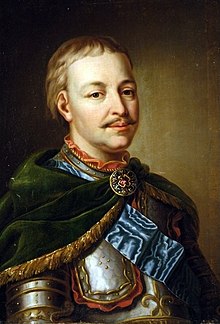Ivan Mazeppa
| Ivan Mazepa Іван Мазепа |
|
|---|---|
 |
|
| Hetman of Zaporizhian Host | |
|
In office July 25, 1687 – November 11, 1708 |
|
| Preceded by | Ivan Samoylovych |
| Succeeded by | Pylyp Orlyk (hetman in exile) |
| Personal details | |
| Born | March 30, 1639 (NS) Bila Tserkva, Kiev Voivodeship, Polish-Lithuanian Commonwealth |
| Died | October 2, 1709 (aged 70) (NS) Bender, Moldavia |
| Nationality | Ruthenian (Ukrainian) |
| Spouse(s) | Hanna Polovets (1642-1704) |
| Religion | Eastern Orthodox (excommunicated from the Russian Orthodox church in 1708) |
| Signature |  |
| Ivan Mazepa | |
|---|---|
| Coat of arms |
Kurcz Coat of Arms 
|
| Noble family | Mazepa family |
Ivan Stepanovych Mazepa (Ukrainian: Іван Степанович Мазепа, Polish: Jan Mazepa Kołodyński; March 30 [O.S. March 20] 1639 – October 2 [O.S. September 21] 1709) served as the Hetman of Zaporizhian Host in 1687–1708. It is claimed that he was awarded a title of Prince of the Holy Roman Empire in 1707 for his efforts for the Holy League. He was famous as a patron of the arts, and also played an important role in the Battle of Poltava (1709) where after learning of Tsar Peter I's intent to relieve him as acting Hetman of Ukraine and to replace him with Alexander Menshikov, he deserted his army and sided with King Charles XII of Sweden. The political consequences and interpretation of this desertion have resonated in the national histories both of Russia and of Ukraine.
The Russian Orthodox Church laid an anathema on Mazepa's name in 1708 and refuses to revoke it to this day. Anti-Russian elements in Ukraine from the 18th century onwards were derogatorily referred to as Mazepintsy (Mazepists). The alienation of Mazepa from Ukrainian historiography continued during the Soviet period, but post-1991 in independent Ukraine there have been strong moves to rehabilitate Mazepa's image, although he remains a controversial figure.
Mazepa was probably born on March 30, 1639, in Mazepyntsi, near Bila Tserkva, then part of the Kiev Voivodeship in the Polish-Lithuanian Commonwealth (today – Drozdy rural council, Bila Tserkva Raion), into a noble Ruthenian-Lithuanian family. His mother was Maryna Mokievska (1624–1707) (known from 1674–75 by her monastic name Maria Magdalena), and his father was Stefan Adam Mazepa (?-1666). Maryna Mokievska came from the family of a Cossack officer who fought alongside Bohdan Khmelnytsky. She gave birth to two children – Ivan and Oleksandra. Stefan Mazepa served as an Otaman of Bila Tserkva (1654), a Cossack representative of the King of the Polish-Lithuanian Rzecz Pospolita, and a Czernihów podczaszy (Cup-bearer of Chernihiv, 1662).
...
Wikipedia
